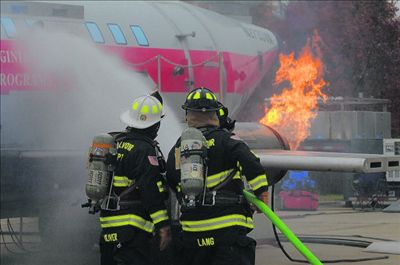
|
| Lt. Danny Oliver and FF John Lang perform training drill. |
|
FORT BELVOIR, Va. (Nov. 23, 2011) -- Fire and Emergency Services Firefighters received Aircraft Rescue and Fire Fighting training Nov. 14-18, at Davison Army Airfield here.
The week-long training consisted of three days of classroom training and two days of simulation exercises. Four groups of four FES Firefighters participated in the training, which gave each firefighter specialized training on how to safely handle an aircraft incident.
Each simulation day lasted for 12 hours.
"Everything we have here on this airfield our people are responsible for," said Assistant Fire Chief Gary Smith, Fire and Emergency Services Training Division. "But, some aircraft that actually come here we don't typically have, and the firefighters have to have familiarization with those aircraft too."
Knowing the structural differences in aircraft is among the main topics covered during the classroom portion of the training. Firefighters learned the differences in where the fuel tanks,
batteries, and oil are located among other utilities in different helicopters and airplanes.
Knowing these differences is critical in how quickly an emergency situation can be handled, according to Smith.
"We have a U-H 1 (Huey) out back and the battery compartments are in the nose cone of the aircraft, but in other aircraft the batteries are in the back of the fuselage, or like in one of the Cessna's they're behind the seats in the storage area where you are supposed to put luggage," said Smith. The sooner firefighters can locate and shut down the utilities, motors and stop fuel leaks the better the chance passengers can get out safely.
During the simulations, the training groups had to put out an engine fire, wheel fire and a fire inside the aircraft. They also had to extinguish a fuel spill fire, which was simulated by a training fuselage.
Each group also had to successfully enter the aircraft with a hose during the interior fire simulation. Additionally, each group member had to complete the primary and supporting responsibilities of each simulation.
Firefighters have to familiarize themselves with how to handle aircraft rescues is important since they don't happen very often, said Fire Fighter/Medic Roger Kennedy, FES.
"We need to continue to train for aircraft rescue because they happen once in a lifetime," Kennedy said. "They're high risk, low frequency calls and those are the scary ones because you don't run them all the time."
Firefighter/EMT AJ Wertz, FES, was one of Kennedy's group-mates during the simulation exercises. He agreed it is important for each FES firefighter to take the training.
"You can't be 100 percent sure of what kind of aircraft you are going to see out there," Wertz said.
The interior fire simulations were the most challenging according to Wertz and Kennedy since a different approach was needed to successfully complete the exercise.
"The fuel spill fire is pretty cut and dry as far as the approach, but the interior was a real challenge," Wertz said.
"The door we went in over the wing of the aircraft was (small)," said Kennedy. "I'm not a skinny boy and I had full gear on, so it brought a challenge."
The importance of pilot communication with the rescue crews was mentioned since pilots usually have everything on the plane turned off if possible when rescue crews arrive.
Being able to successfully complete each step of an aircraft rescue is one of the main goals of the training, but seeing how far the firefighters can be pushed may be the most critical part, according to Smith.
"We put the firefighters under task and time, here, to be able to push them to their edge," said Smith. "They don't know what they can do until they know where their edge is."
By Justin Creech, Belvoir Eagle
|

